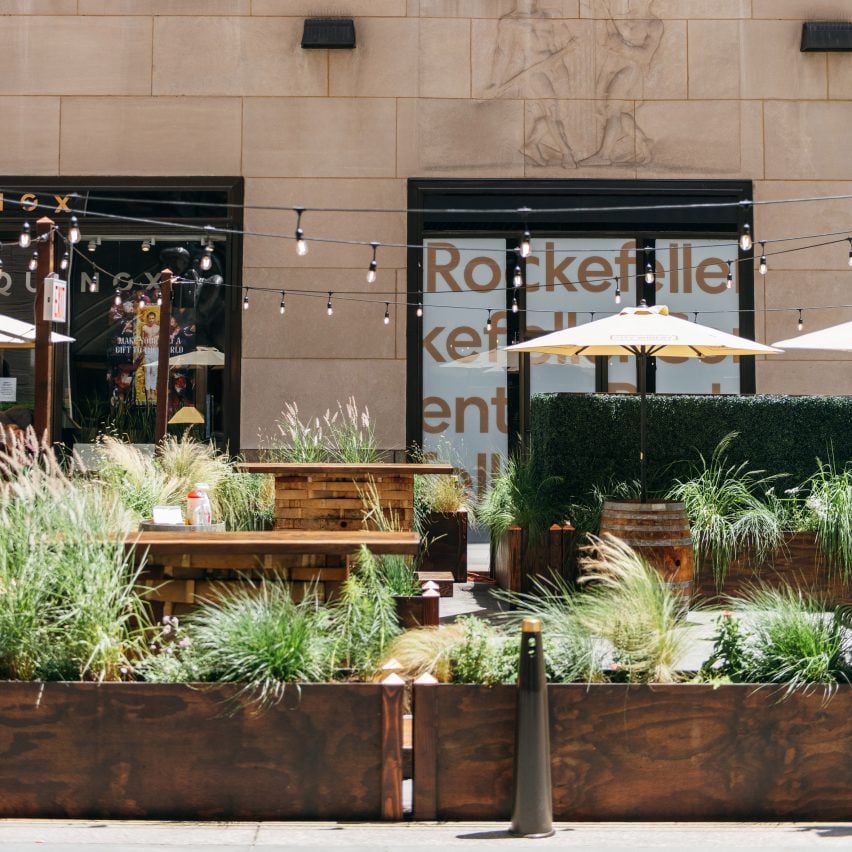
Biodiversity and effects of climate change can be significantly affected by small-scale rewilding projects argues designer and environmentalist Julia Watson, who has temporarily covered New York's Rockefeller Center plaza and ice rinks with plants.
Named Rewilding the American Meadow, the project covers the North Plaza and Ice Rink of the Midtown Manhattan complex with wooden pots containing plants from the northeast of the United States.
Working with horticulturist and planting designer, Marie Salembier, Watson chose plants with a wild American meadow in mind like native grasses, perennials and trees indigenous to the north-east region.
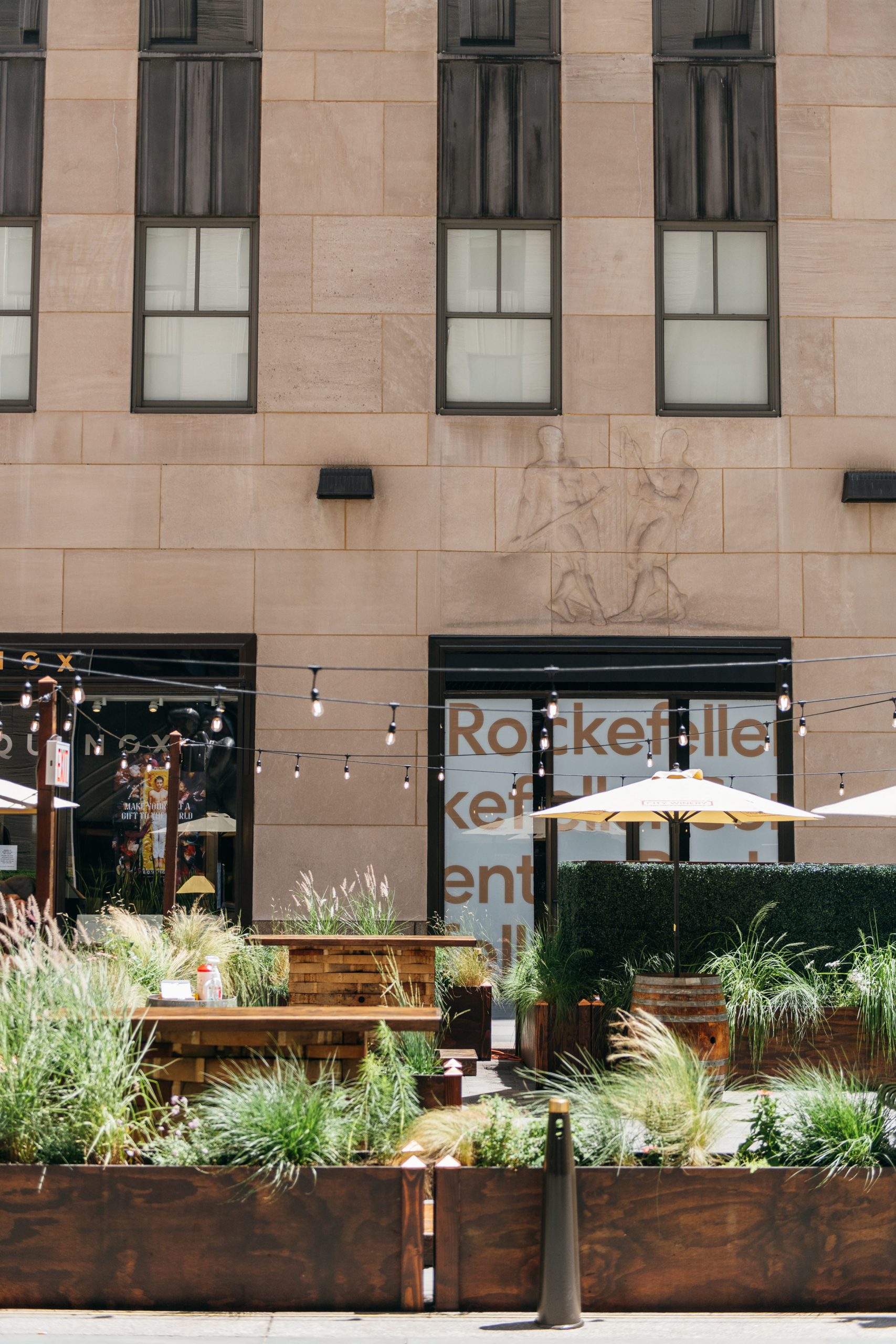
The designer called the scheme a rewilding, which aims to allow natural habitats to recover with minimal human intervention, as a nod to the fact that the area where the Rockefeller Center stands was formerly home to the Elgin Botanic Garden. Watson said at the time it contained 2,000 native and rare exotic species.
She believes that urban rewilding is an example of how to improve biodiversity in cities, bolster pollinators and help provide clean air.
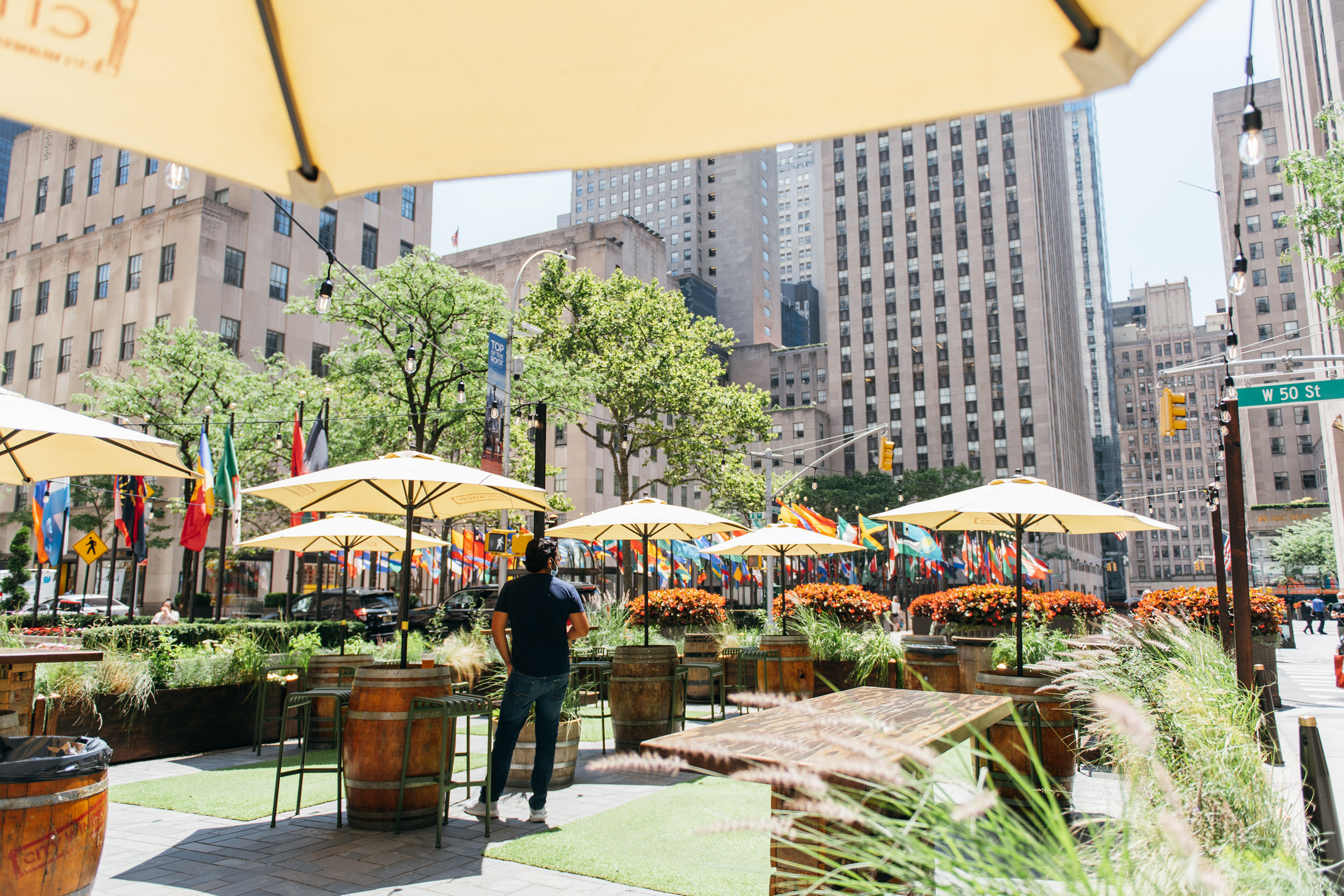
"Rewilding the American Meadow at Rockefeller Center's North Plaza and Summer at The Rink are part of an idea we have that envisions entities with significant global property portfolios becoming catalysts for mitigating climate change in our urban environments," Watson told Dezeen.
"By matching indigenous, rare, and threatened plant species to local property portfolios around the globe, these urban rewilding projects could replace the homogenous and predominantly ornamental urban landscapes that form the backdrops of our cities today," she continued.
"By thinking of this as a multi-scalar global project, we can conceive how these ideas become mainstream and could have that explosive, emergent impact towards increasing global biodiversity that we need, while also celebrating local ecosystems, cultures, colours and identities."
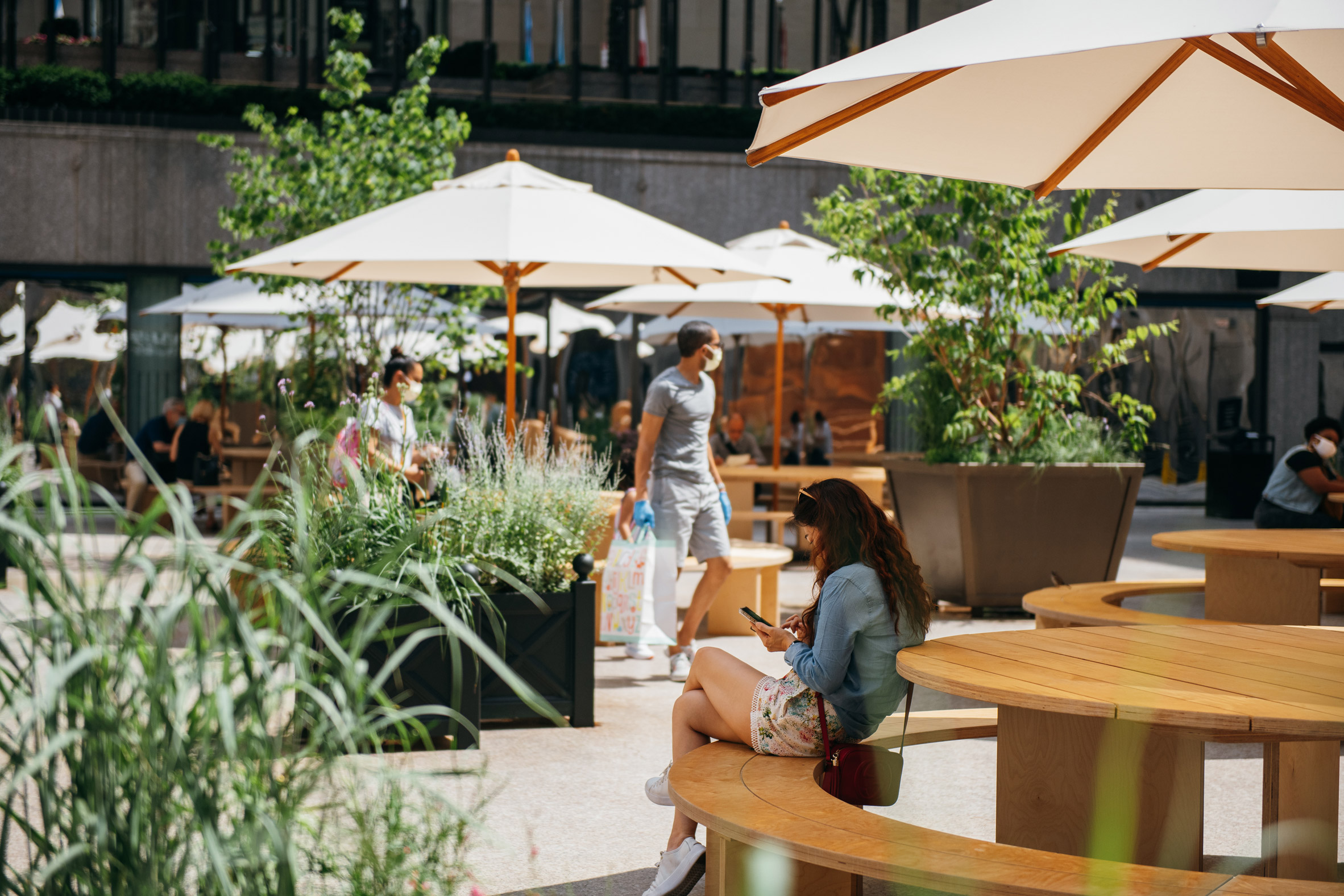
Watson and Salembie chose a range of plants that would bloom at different times over the duration of the installation from July until November.
"I was onsite for both of the installation days and before the gardening team had finished transferring the plants from pots to the planters, we had pollinators like bees and butterflies already feeding on the blooms," she said.
"That's honestly the highest form of appreciation."
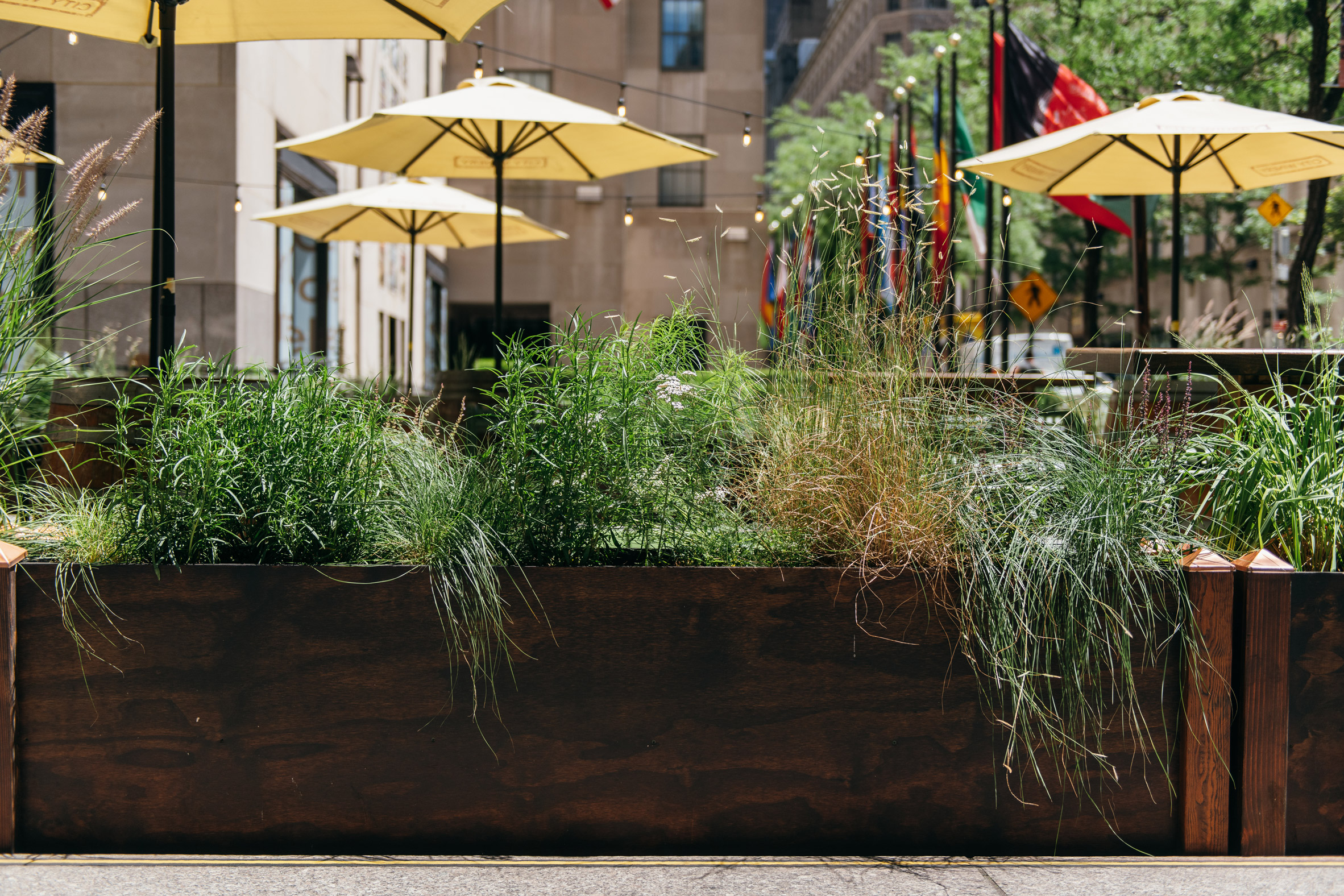
While the temporary project is relatively small scale, Watson argues the plants will have many knock-on effects. For example, they will attract animal and insect species like birds, bees and butterflies that will help with pollination of surrounding environments in the city over the next year.
"If you think of these temporary planters as seeding the growth of next year's indigenous plants within the local radius that the pollinators move throughout, that means the summer gardens will have that unknown and cascading effect on the local ecosystem of Central Park and other larger landscape patches throughout the city," she explained.
"These blooms provide the energy for the pollinators needed at this time of the year and another stopping point for the pollinators as they make their way through the city landscape," she continued.
"We will then indirectly effect next year's populations by providing for this year's colonies so that when we design these gardens again next year, we'll provide the same support systems for new colonies."
Watson added that it is these effects of rewilding that make it far more beneficial in comparison to conservation projects.
"Rewilding is so important because it takes an active, rather than passive approach to ecosystem conservation and regeneration," she said. "It works to introduce systemic change that leads to cascading effects that are emergent and open-ended. This is a really fascinating design approach, and one that I bring to my work."

Watson teaches urban design at Harvard GSD and Columbia GSAPP, and is author of LO–TEK Design by Radical Indigenism, in which she argues that tribal communities, seen by many as primitive, are highly advanced when it comes to creating systems in symbiosis with the natural world.
She said the Rewilding the American Meadow shows how these philosophies can be used to change how we design cities.
"This project really speaks to a core concept of LO—TEK, which is, as a species, the vast majority of humans on this earth need to foster a more nature-based culture," she said.
"In my book LO—TEK, I discuss designing with biodiversity and document indigenous technologies from the scale of the module, to the structure, system and infrastructure," Watson added.
"This really means that biodiversity literally becomes the building block for these technologies, just as it becomes the building block for the design at Rockefeller Center and in the processes of rewilding."
Read on for our full interview with Watson:
Marcus Fairs: How did the project come about?
Julia Watson: Rewilding the American Meadow at Rockefeller Center's North Plaza and Summer at The Rink are part of an idea we have that envisions entities with significant global property portfolios becoming catalysts for mitigating climate change in our urban environments.
By matching indigenous, rare, and threatened plant species to local property portfolios around the globe, these urban rewilding projects could replace the homogenous and predominantly ornamental urban landscapes that form the backdrops of our cities today.
In Rewilding the American Meadow, we used tree species like Cercis canadensis or Eastern Redbud, which offer colourful fall flowers that attract honeybees; Oxydendron arboruem or Sourwood, which has a honey that is considered a delicacy; and fruit that persists throughout winter, which is attractive to birds and helps them survive through the winter.
We hope the design of rewilding gardens as forming part of a larger ecosystem
These native trees were underplanted with Asclepias incarnata or Swamp Milkweed, Echinaceae purpurea or Purple Coneflower, and Achillea millefolium or Yarrow, which is a classic but great for a long blooming season and for pollinators.
We hope the design of rewilding gardens as forming part of a larger ecosystem encouraging on-site programmes that would include local seed banking, on-site propagation, farmers markets with educational programs, and seed exchanges.
By thinking of this as a multi-scalar global project, we can conceive of how these ideas become mainstream and could have that explosive, emergent impact towards increasing global biodiversity that we need, while also celebrating local ecosystems, cultures, colors and identities.
Marcus Fairs: How does it relate to your other projects and your book?
Julia Watson: This project really speaks to a core concept of LO–TEK, which is, as a species the vast majority of humans on this earth need to foster a more nature-based culture. The tenets of that culture could be universal, but the manifestation should be inspired by the diversity of local cultures.
In my book LO–TEK, I discuss designing with biodiversity and document indigenous technologies from the scale of the module, to the structure, system and infrastructure. This really means that biodiversity literally becomes the building block for these technologies, just as it becomes the building block for the design at Rockefeller Center and in the processes of rewilding.
This is all part of a grander scheme to champion the regeneration of threatened plant species
In LA I'm working on a project for the City of El Segundo to redesign the Gateway to the City, where we're taking that idea of the spectacle of LAX airport and enhancing that sensory experience by introducing an ecological runway, for butterflies and other photoreceptive insects, to the Pacific Ocean.
The ecological runway will manifest as a diurnal photoreceptive pollinator corridor designed to regenerate the indigenous habitat of the threatened, native El Segundo Blue Butterfly. While in the Cotswalds, we're working on a rewilding master plan of a sheep farm that's be regenerated and will house an artist's residency program in Warwickshire.
Marcus Fairs: Why is it important to use native plants in projects like this?
Julia Watson: With my design partner Marie Salembier, a horticulturist and planting designer, we've been envisioning ways to bring the language of botany and biodiversity back to the city as an educational experience.
This is all part of a grander scheme to champion the regeneration of threatened plant species, which are connected to habitat loss and the mass extinction of our pollinator populations, which form the basis of our food webs.
Marcus Fairs: How has the project been received by both people and local wildlife?!
Julia Watson: Tishman Speyer has been a great Client and everyone has commented on how fantastic the greenification looks. The Rockefeller Center gardening team is incredible and they're been very gracious through-out this collaboration and receptive to new ideas. The local tenants of the restaurants around North Plaza have been featuring the rewilding in their social media and people seem to really appreciate the beauty and biodiversity, which isn't always the case when using natives.
Rewilding is so important because it takes an active, rather than passive approach
I was onsite for both of the installation days and before the gardening team had finished transferring the plants from pots to the planters, we had pollinators like bees and butterflies already feeding on the blooms. That's honestly the highest form of appreciation.
Marcus Fairs: Rewilding is becoming a hot topic – in your view why is it important?
Julia Watson: I've been outspoken in my criticism of Conservation in LO–TEK. Rewilding is so important because it takes an active, rather than passive approach to ecosystem conservation and regeneration.
It works to introduce systemic change that leads to cascading effects that are emergent and open-ended. This is a really fascinating design approach, and one that I bring to my work.
Landscape architecture is a unique design profession in that it offers the ability to interact with ecosystems by opportunistically amplifying specific conditions, creating symbiosis, or catalyzing interactions that set up an evolving scenario. As a designer, I can envision parts of that evolving scenario and the alternative future, but not all of it.
We redefine rewilding as a radical revision of urbanism's taming of nature, towards a new wildness in localism
In working with dynamic and living ecosystem interactions, there is a wildness and a beauty in the unknown of a future that's still to evolve that you've helped to create. It's that richness and potential that is nature, which we as designers are still trying to understand and grasp in our work.
Elizabeth Meyer wrote a fantastic essay a couple of years ago about finding that beauty in the design of sustainable landscapes. I feel we're having a revival at this moment, in which we're re-exploring traditional, technical and ecological aspects within design that are redefining our conceptions of beauty along the way.
Marcus Fairs: Can this kind of project really be considered as "rewilding"? Can the term really be applied to temporary projects with plants in containers?
Julia Watson: Typically defined as restoring an ecosystem, in our studio we redefine rewilding as a radical revision of urbanism's taming of nature, towards a new wildness in localism. We envision biodiversity as becoming the building blocks of diverse, local symbioses between species, peoples and place.
As for temporality, that's a cyclical phenomena that's characteristic to nature.
The planting palette for the summer gardens at Rockefeller Center is designed with a staggered flowering cycle, so different blooms will be continuously present from July to October.
Pollinators have their own life cycles geared towards the spring summer and autumn seasons. These blooms provide the energy for the pollinators needed at this time of the year and another stopping point for the pollinators as they make their way through the city landscape.
Think of these temporary planters as seeding the growth of next year's indigenous plants
We will then indirectly effect next year's populations by providing for this year's colonies, so that when we design these gardens again next year, we'll provide the same support systems for new colonies.
We're also indirectly increasing the life supporting systems for ourselves. This happens as native flora attracts the native fauna essential for pollination. In turn, these species assist in the reproduction cycle of the plants.
If you think of these temporary planters as seeding the growth of next year's indigenous plants within the local radius that the pollinators move throughout, that means the summer gardens will have that unknown and cascading effect on the local ecosystem of Central Park and other larger landscape patches throughout the city.
The plants we are bringing to the summer gardens are also assisting mature in cleaning the air we breathe and the pollinators they attract are helping to grow the food we eat.
Marcus Fairs: How can architects and designers help increase biodiversity and tackle climate change through their work (particularly in urban areas)?
Julia Watson: When we ask these type of questions we're really directing our responses to a few urban environments that we're very familiar with, have probably lived in or travelled to. For those, we have a modest set ideas for how we can tackle climate change. But our profession is informed by a legacy of industrialization and modernism.
This legacy limits our understanding of what technology is, what innovation is, and what our cities could become. For so long we have all believed that high-tech and fast growth is the future. I don't think many of us have really, deeply negotiated a radically different alternative future.
Seriously and strategically tackling biodiversity and climate change at a global scale is not going to happen by applying a one size fits all approach designed by affluent cities to be applied to the diversity of ecosystems across the globe. This approach is inconsiderate of the resource availability and economic feasibility of individual cities and their communities. In looking for solutions for the whole planet, we cannot follow the current mythology of technology that calls for a scaling of costly, high-tech, and hard infrastructural strategies.
Designers will have the most impact on climate change by collaborating with local communities
Designers need to look elsewhere – at effective responses that are symbiotic with specific environments and the availability of resources. Communities in developing countries can still leap-frog the typical model of progress that ends in the displacement of indigenous diversity for the sake of homogenous high-tech.
In LO–TEK, we find nature-based systems that symbiotically work with the environment. These nature-based systems act multidimensionally, for example not only for the purpose of food production but also as resilient infrastructures that may survive industrial agriculture, as seas rise and climates change.
They are ecologically-intensive, rather than energy-, chemical-, or capital-intensive. They are technologies that already embody the construction techniques, climate, soil quality, precipitation levels, and seasonal understandings of the local culture and the ecosystem that evolved them. They amplify ecosystem services rather than erase them.
Designers will have the most impact on climate change by collaborating with local communities and taking the time to understand the intelligence of local knowledge, practices and technologies. They can assist in the scaling and systematic expansion along with development of these LO–TEK systems.
In return, the profession will also be expanding the toolkit of available resilient technologies that could be adapted, hybridised, innovated in consultation with these communities. As we look for ways to design resilient technologies in the face of climate change, we must look at systems that are proven to work, as Dr Eugene Hunn puts it, "tested in the rigorous laboratory of survival".
Marcus Fairs: How can cities help encourage biodiversity and mitigate climate change?
Julia Watson: Cities can explore nature-based infrastructures that are active, adaptive, and productive, involving co-existences of many species, and using biodiversity as a building block - thereby harnessing the energy and intelligence of complex ecosystems. This is how humans have been dealing with the extremes we now face for millennia.
Nature-based technologies align with today's sustainable values of low-energy, low-impact, and low-cost. Climate change is showing that our survival is not dependent upon superiority, but upon symbiosis - and cities must shift how they develop in their second and third growth rings towards integrating these symbiotic technologies.
Marcus Fairs: What do you think will be the long-term impacts of Covid-19 on the design of cities?
Julia Watson: Historically pandemic has transformed cities. The bubonic plague led to the Italian Renaissance, one of the greatest epochs of art, architecture and literature in human history. The Spanish flu championed the City Beautiful Movement, introducing parks, wide streets, and clean water, remaining at the forefront of urban design for many years. But the current pandemic in the context of climate change is different.
The response to Covid-19 must displace the homogeneity and monoculture of globalism and urbanism
Hopefully today's response will not be limited to sanitation and beautification because there are ecological explanations that connect reduced resilience to pandemic. These include habitat encroachment causing zoonotic transfer, reduced biodiversity causing single species dominance leading to increased incidence of human contact, and reduced environmental resilience in the face of climate extremes, leading to poverty, risky behavior, migration which all increase the incidence of viral transmission.
So the response to Covid-19 must displace the homogeneity and monoculture of globalism and urbanism that is crippling our cities and agricultural landscapes and making our systems vulnerable. Design must lead us toward the rediscovery of resilient localisms.
The pioneers of nature-based design and technology are indigenous communities, whom are often seen as primitive, but in reality are highly advanced when it comes to creating systems in symbiosis with the natural world. Having studied indigenous communities across the globe for twenty years while training as an architect, landscape architect and urban designer, the evolution of design towards integrating these nature-based technologies and the eventual change this integration could have on the way we design cities, is now within our reach.
Photography of Rewilding the American Meadow is courtesy of Rockefeller Center.
Project credits:
Project team: Watson Salembier, Anna Karlin Studio, 2x4 Workshop
The post Julia Watson fills New York's Rockefeller Center plaza with native American meadow plants appeared first on Dezeen.
https://ift.tt/3joUt37
twitter.com/3novicesindia
No comments:
Post a Comment